Our content is reader supported, which means when you buy from links you click on, we may earn a commission.
Incorporating Cognitive Learning Theory Strategies in Your Next Online Course

When you were a student in school, some subjects were easy for you to understand and you wound up with better grades in those subjects. But other topics were challenging regardless of how hard you tried.
The same happens to online learners every single day.
Some people understand new concepts faster, while others struggle to catch up. Therefore, instructors must help all learners understand the material. An online course instructor can help learners cope with such struggles in several ways.
One way you can help is by understanding the different power tools at your disposal, especially cognitive theory.
Cognitive theory depends more on how a person thinks and understands concepts, especially those presented by an educator or a teacher. There is solid evidence that this learning strategy plays a massive part in unlocking concepts learners find hard to grasp and process. It also motivates learners to be confident.
The primary goal of cognitive strategy instruction is to impact learners’ knowledge and skills. This guide will give you a deeper understanding of such strategies relating to cognitive skills which will help you develop effective course content.
What is Cognitive Learning Theory?
Before delving into anything else, let’s begin with understanding the metacognitive strategies.
Metacognition is the attentiveness of your brain’s judgments and judicial processes. This lies as the basis of the cognitive learning theory.
Cognition is the psychological process of acquiring knowledge through experiences, senses, and thoughts.
Cognitive learning theory is a technique that focuses more on how active the brain of the learner is. This set of learning tactics enables the learner to be attentive and fully engaged. With cognitive learning, you do not have to memorize or repeat things to understand. You just understand.
Cognitive learning is all about learning how to learn.
Mastering the art of cognitive learning enables you to understand and remember things for an extended period of time. The principal aim of this system is to enchant the learner with optimal understanding, knowledge, and retention of the instruction.
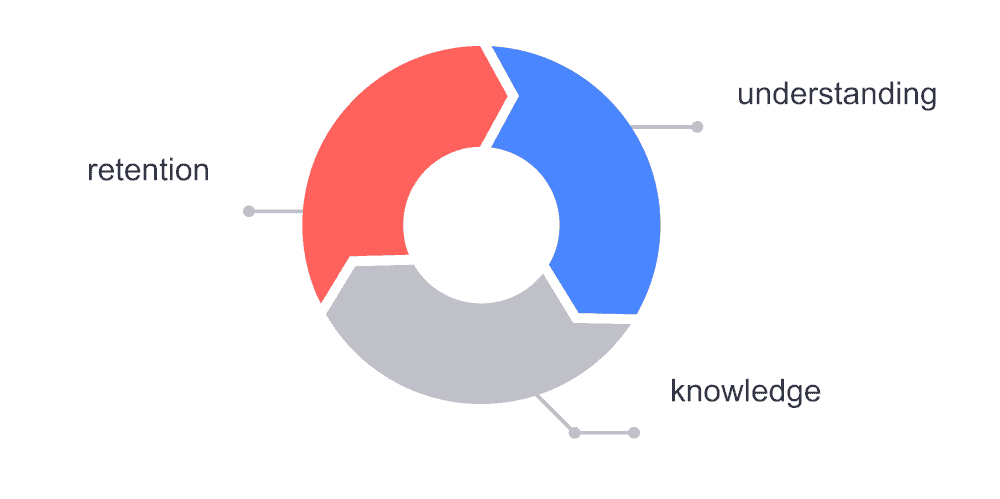
For cognitive theory to work, you must ensure that you enhance cognitive processes. Failure to execute these processes will make the learning process ineffective, challenging, and difficult to understand.
These processes include categorizing, observing, and generalizing the environment. Disrupting any of these processes can result in behavioral problems among the learner. Thus, the solution will lie in changing the interrupted process.
For instance, a man who has an eating disorder will tend to think that he is overweight. The cognitive disruption makes him believe that he has extreme weight. A therapist will manage to traverse his mindset of thinking that he is overweight to change unhealthy eating. Obviously, used this way, cognitive disruption can have positive effects.
Origin and Background of Cognitive Theory
This theory has a unique and exciting history. Two philosophers that delved into this theory deeply were Plato and Descartes. They had terrific ideas on how behavior could have an impact on knowledge, leading to further thoughts on cognition.
This led to psychologists and researchers, such as William James, Wilhelm Wundt, John Watson, and John Dewey, to research how the mind and thoughts work. The involvement of Jean Piaget allowed for even further discoveries. Piaget delved more into understanding the growth levels that break down the knowledge abilities and ages.
The invention of computers lead to further understanding of the mind and made it easy for us to have a comprehensive view of the human brain.
Elements of Cognitive Learning
Cognitive learning differs a lot from traditional learning.
Traditional learning mainly involves memorizing or repeating the subject or concept for an extended period. Rote repetition is one such method.
Cognitive learning, on the other hand, consists of mastering the concept or topic. Some factors play a significant role in ensuring that cognitive way of learning is successful. They include memory, comprehension, interpretation, and application.

Memory
Cognitive learning discourages just using rote learning. With cognitive learning, you have to have a deeper understanding of the subjects than when using passive learning strategies. This will help the learner recall new things using past information.
Comprehension
The learner must have a good reason as to why he is studying your lesson. Furthermore, the learner must know the importance of learning. Moreover, this element also breaks down how the skills learned will assist in the future.
Interpret
The learner must be able to understand and interpret the information without disruptions.
Application
Cognitive learning strategies require that the learner applies the interpreted information in future and current situations. With an understanding of its application, the learner can solve problems efficiently and moves toward becoming a critical thinker. Furthermore, learners also gain visionary leadership traits from learning how to solve problems.
Benefits Associated with Cognitive Learning
Cognitive learning is the best way to foster a life-long love of studying among your online learners. Below are some ideas on how cognitive learning strategies affect learners.
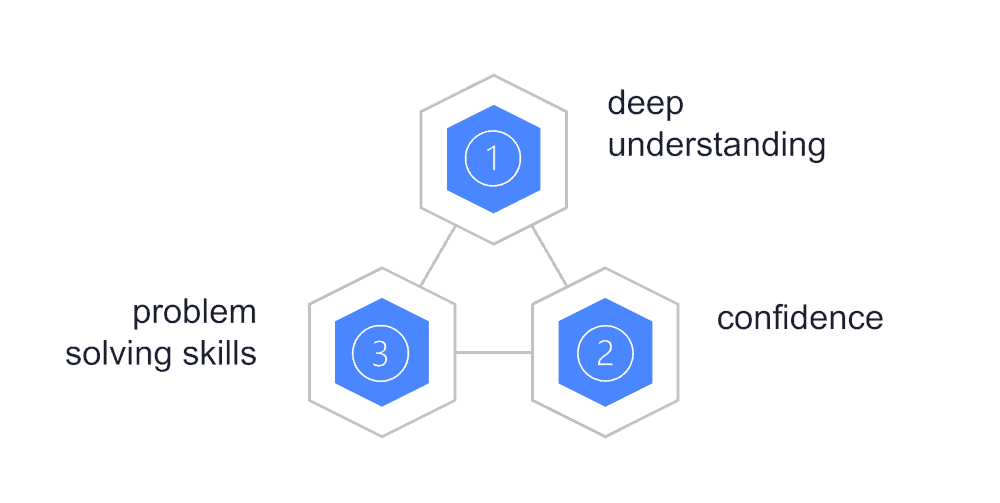
- Cognitive learning enables the learner to understand deeply, thus promoting comprehension. This way, the students’ understanding increases. They have a good grip on what you are teaching and how to apply it in life.
- Cognitive learning boosts the learner with confidence on how to handle challenges of life.
- Cognitive learning equips the learner with problem-solving skills, which are essential in any leadership platform. Furthermore, they will also have confidence when applying the skills.
Cognitive learning promotes continuous learning and long-term learning. It ties the learner’s past information with new information and applies them effectively.
Albert Bandura, a well-known professor from Stanford, developed social cognitive theory. The theory describes how the environment affects the understanding of people.
Social cognitive theory explains how a learner can acquire knowledge by observing others within the context of experiences and social interactions.
The theory states that once a human observes another person’s behavior and the consequences, they learn and use this information for future reference.
In simple words, learners do not learn new things by trying and failing or succeeding. They sorely depend on other actions and replicate them in day-to-day activities. Thus, the learner may rely on replicating the behavior even though the model is rewarded or punished.
Origin and Background of Social Cognitive Theory
Edwin B. Holt and Harold Chapman Browns were the first people to delve into social cognitive theory. They created a pathway in 1931 for other philosophers to follow suit.
They argued that rewards, responses, cues, and drives were the factors that affected learning.
Albert Bandura, together with his learners, conducted an experiment to help learn why some children show aggressive behavior. In 1977, he published an article using the results which he argued showed a direct relationship between a learner’s archived behavior change and self-efficiency.
Later, he published a new article and renamed his original theory ‘social cognitive learning theory’. The name change emphasized how cognition affects the behavior change of learners. In the article, he stated that environmental, behavioral, and personal influences cause behavior change.
Modeling and Observational Learning
This theory revolves around the acquisition of knowledge by observing other models. The models can either be media sources or interpersonal imitation. Therefore, an effective instructor can equip online learners with strategies and rules to use in different scenarios.
To prove that people acquire knowledge from watching others, Albert Bandura conducted the Bobo doll experiment. A large group of children was stationed with aggressive and non-aggressive models of the same toy. The first set of dynamic learners and children was to play with the toy aggressively, and the other group was to play with the dolls non-aggressively.
The results proved that the children exposed to aggressive models acted aggressively towards the Bobo doll afterward compared to the other group. After testing the theory using models, Albert turned to the media to see if it had the same impact on the children.
From these two experiments, modeling plays a massive role in equipping the learner with knowledge and other skills. For instance, if a teacher punishes a learner who is doing wrong, other learners will suppress the behavior to avoid the same punishment.
Observational learning occurs in four processes that include:
- Attention process – Learners focus on specific behavior depending on relevance, accessibility, and complexity of the response.
- Retention process – Learners observe and enumerate the consequences of a particular behavior, then hold the action for the future.
- Production process – Learners recreate the memories retained and apply the acquired skill in relevant scenarios.
- Motivational process – Learners can perform the skill depending on the adverse and desired outcomes. If the observer received an award, the learner would be highly motivated to complete the task and vice versa.

The Role of Self-Efficacy
Instructors can also have a significant impact on the learner’s self-efficacy belief to work on observed behavior. For instance, when learners see others succeed, they also create the confidence that they can also thrive. Therefore, you tend to be a source of inspiration and motivation.
Self-efficacy plays a considerable role in motivating the learner to pursue a particular task. Furthermore, it will influence the learner’s belief in overcoming challenging tasks and how to solve the challenges.
What are the Types of Cognitive Learning?
There are three types of cognitive learning; classical conditioning, operant conditioning, and observational learning. Let’s go through each of these briefly.
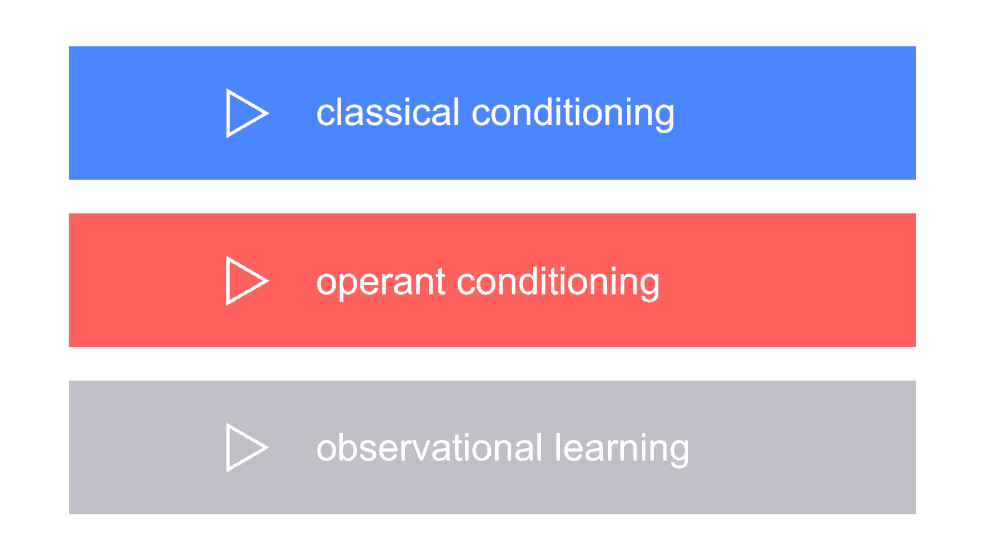
Classical Conditioning
This a type of conditioning where two stimuli are linked together to produce a new learned response. Classical conditioning was initially discovered as an excellent form of learning in dogs and other canines, which was later used in humans.
Classical conditioning in humans is found in reactions such as nausea and anger. For instance, the smell of a particular food might upset your stomach leading to vomiting.
Classical conditioning is used to change behavior in humans using behavioral therapy, such as aversion therapy. Aversion therapy is a type of treatment associated with encouraging someone to stop or change a specific action such as smoking. This has been an effective treatment for phobias. Through this treatment, the learner is trained to be calm in conditions that he is afraid of.
Classical conditioning is also an essential tool in other realms. In the field of advertisement, cell phone commercials advertised on the television are created to be attractive and appealing to the customer. If the cell phone is appealing, the customer will believe that the model is of high quality and meets the customer’s standards.
Classical conditioning is all about the experiences. If a learner eats seafood for the first time and that results in food poisoning or stomach upset, he will protect himself from eating that type of food again.
Operant Conditioning
Operant conditioning is also known as instrumental conditioning. This is a method of learning that employs rewards and punishments for behavior. In operant conditioning, an association is made between the action and consequence, which is either positive or negative.
Critical concepts in operant conditioning include reinforcement and punishment. Support is anything that strengthens or increases the behavior it follows. Positive reinforcements are like the implementation of rewards after a good outcome.
For instance, as a learner, you perform well in a classroom setting, you are rewarded, and that keeps you motivated. On the other hand, negative reinforcement results in removing privileges after displaying harmful or unwanted behavior.
Punishment in operant conditioning is the action that is taken and that causes a decrease in behavior. Positive discipline can include offering a suspension for some weeks or depriving the learner of things they love like cell phones and accessories.
Shaping is another form of the operant conditioning method that helps the learner in acquiring knowledge. Rewarding proper behavior and discouraging improper behavior achieves this. For instance, the training of performance dogs uses the principles of operant conditioning.
Observational Learning
We learn through watching others and then imitating or modeling what they do. As the saying goes, ‘monkey see monkey do’ is true in both humans and animals. Four conditions are necessary for observing and modeling behavior. These include attention, retention, reproduction, and motivation.
If a subject is to learn anything new from a model, they must first pay attention to what it does. Retention is the ability to recognize the behavior you witnessed to imitate it.
Reproduction involves the physical and mental ability to copy the behavior observed. This is profoundly affected by motivation. There could also be factors that lead to negative motivations.
For instance, if an observer sees the model as being punished for a specific behavior, then the probability of imitating the behavior becomes less probable.
Observational learning can help in therapeutic conditions. Modeling can assist patients in overcoming phobias.
For instance, those with claustrophobia may observe a model moving closer to the area. The model then enters the space and closes the door behind it. The patient is taught relaxing and calming techniques, and if they continue practicing what they have observed, they overcome their phobias over time.
Observational learning applies to many situations. For instance, children observing their parents washing clothes may demonstrate the same actions. This holds implications for teaching.
The extent of observational learning varies with the cultural and social backgrounds of an individual. People that belong to communities with an emphasis on reinforced education may have less observational learning skills.
The Navajo people who hail from the United States’ southwestern region are an example of cultural influence on observational learning and do not teach their young ones. Instead, they have them into their daily activities, so they learn on their own.
Examples of Cognitive Learning
The following are concrete examples of different types of learning:
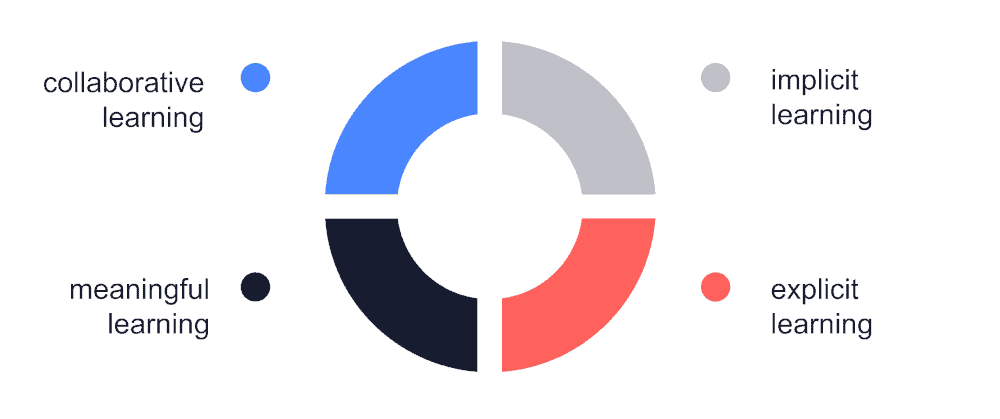
Implicit learning is a form of automatic or accidental education that you are not aware of, but in the end, you find that you have retained the knowledge. For instance, walking, talking, and eating are examples of implicit learning.
Explicit learning involves seeking the knowledge you get while knowing. It consists of attempting the new skill. You have to pay attention to gain understanding. Examples of explicit learning include furthering your studies or trying to master something.
Meaningful learning is when one relates the new knowledge learned with prior experience and information. It involves emotions, motivation, and cognitive aspects and deepens knowledge and problem-solving skills. For instance, meaningful learning occurs when you want to further your computer skills to become better in technology and have a deeper understanding of how the technology works.
Co-operative and collaborative learning involves learning as a team or as small groups through discussion. Having an active small-group discussion consequently leads to the ushering in of a deeper meaning. It includes various elements like simultaneous interaction, positive interdependence, individual responsibility, and equal participation.
The following are different examples of cognitive learning:

Habituation and Sensitization
Habituation involves a reduced reaction to a stimulus after prolonged exposure. For instance, a person working in an industrial business hardly notices noise since, with time, the sound will start to fade and not bother them anymore. The reason behind this is that they have learned to ignore the stimulus. Sensitization, on the other hand, makes you adapt to your phone ringtone and end up picking up the phone.
Transformation
With transformation, a learner simplifies a complex task to something more simple. For instance, using imagery to transform difficult tasks into meaningful visual and kinesthetic information. Through mnemonics, a learner transforms information by relating a phrase or sentence to the target information.
Rehearsal Strategy
Rehearsal strategy enables a learner to practice information through verbalization and visual study. A learner can practice vocabulary and definitions through games where they must orally or mentally repeat the information. Moreover, through elaboration, a learner can relate data to other forms of information. For instance, comparing the life of an ant colony to our community.
What are Cognitive Learning Strategies?
Essentially, cognitive learning encourages learners or people to develop a deeper understanding by exploring the materials involved. Through cognitive learning, learners can create problem-solving skills that can be applied effectively.
Here are some strategies for using cognitive learning in your online training:
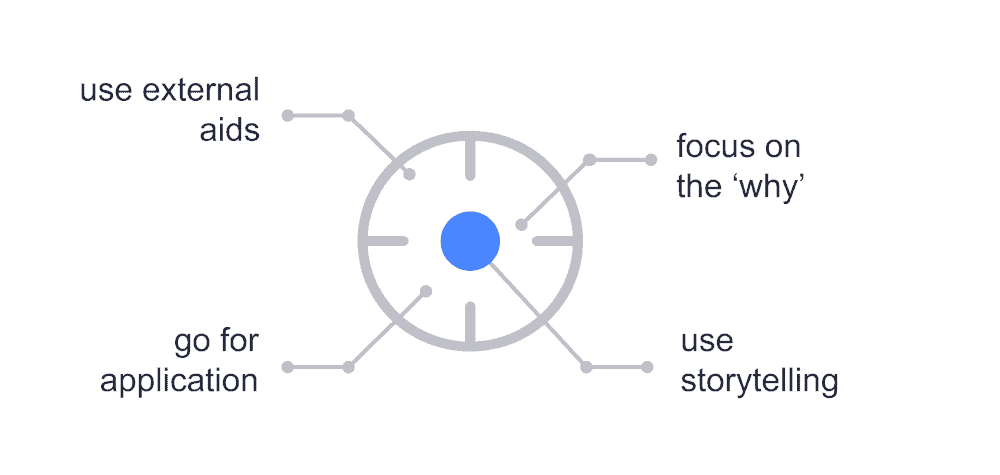
Focus on the ‘Why’
Some strategies influencing cognitive learning include working on comprehension where learners understand the ‘why’ behind the concept. If learners understand why they’re learning something, they can start to understand its importance.
One way to help them understand the ‘why’ is to make sure the learning goals of the course are clear and concise. Tie them back to something that will be seen as important to all the learners for the course.
Use Storytelling
The other is to trigger a memory that helps learners gain a deeper understanding. Often this can be solved through storytelling. So even though it’s not their memory, it’s an association between a story the instructor is telling and the concept.
Creating associations makes the information more memorable. It increases reading comprehension. Retrieval practice increases a learner’s retrieval strength and long-term memory of the material. That means they can retrieve the information much faster and easier.
Go For Application
Another cognitive learning strategy is to work on application. This allows learners to have the ability to create problem-solving skills. Application can be factored into online training through the use of tests and quizzes. Where you’re not only quizzing learners on the main concepts but asking them to apply those concepts in order to arrive at the correct answer. Application can also be worked on through question and answer sessions where the material is covered at a deeper level.
Use External Aids
Cognitive strategies can also include using external aids such as calculators to help in complicated math. Or a clock to help keep track of the time. They can also include communicating strategies, like seeking help
FAQs on Cognitive Learning
What is an example of cognitive learning?
If you learn how to drive a car, you are engaging in cognitive learning. This is because you are acquiring new information (how to operate a car) and new skills (how to control the vehicle).
Cognitive learning can also involve changes in our attitudes and beliefs. As an example, if you learn about the dangers of drinking and driving, you may change your attitude towards driving after drinking alcohol.
What are the three types of cognitive learning?
There are three main types of cognitive learning: verbal, visual, and auditory. Each type of learning involves taking in information through a different channel. Here’s a breakdown of each type:
- Verbal learners prefer to learn through spoken language.
- Visual learners prefer to learn through pictures and diagrams.
- Auditory learners prefer to learn through listening to lectures or audio recordings.
All three types of learning are important and can be used to supplement one another. For example, a visual learner may benefit from listening to an audio recording of a lecture in order to better understand the material. Similarly, an auditory learner may benefit from reading a textbook alongside listening to a lecture in order to better remember the information.
What are cognitive learning activities?
Cognitive learning activities are activities that help you learn and remember information. They can involve different cognitive processes, such as problem-solving, decision-making, and critical thinking.
Some common cognitive learning activities include puzzles, brain teasers, and memory games. These activities can help improve your cognitive skills and abilities, and can also be enjoyable and challenging.
Cognitive learning activities can be used for both educational and recreational purposes.
Is ADHD a learning or cognitive disability?
ADHD (Attention Deficit Hyperactivity Disorder) can definitely make it harder to learn and remember things, but it’s not always classified as a learning disability. While ADHD can make it tough to focus and stay organized, it’s not always considered a cognitive disability either.
ADHD is a brain disorder that makes it difficult to pay attention, control impulsive behavior, and/or stay focused on a task. While it’s not technically categorized as a learning or cognitive disability, it can still have a significant impact on those areas of life.
What are the four phases of the social cognitive learning theory?
The social cognitive learning theory postulates that there are four phases to learning: attention, retention, motor reproduction, and motivation.
- In the first phase, attention, the learner focuses on a task or behavior. In order to learn something new, we must first pay attention to it.
- The second phase, retention, is when the learner remembers what they have learned. This can be aided by repetition and practice.
- The third phase, motor reproduction, is when the learner actually performs the task or behavior. This is often where mistakes are made as the learner is still perfecting their skills.
- The fourth and final phase, motivation, is when the learner is driven to perform the task or behavior. This can be intrinsic (coming from within oneself) or extrinsic (coming from external factors).
What is cognitive machine learning?
Cognitive machine learning is similar to the way humans learn, and it allows machines to improve their performance over time without needing to be explicitly programmed.
Cognitive machine learning differs from traditional machine learning in that it does not require humans to provide labels or categories for data. Instead, in cognitive machine learning, algorithms are able to automatically detect patterns and extract meaning from data. This makes cognitive machine learning well suited for tasks such as image recognition, natural language processing, and facial recognition.
What is cognitive learning theory in education?
Cognitive learning theory has its roots in cognitive psychology, and it emphasizes the role of mental processes in learning. According to cognitive learning theory, learners are active participants in their own learning, and they construct meaning by integrating new information with prior knowledge. This theory has been applied to a variety of educational contexts, and it has contributed to our understanding of how students learn.
What are the six cognitive learning objectives?
The six cognitive learning objectives are: knowledge, comprehension, application, analysis, synthesis, and evaluation.
When planning your lessons, try to incorporate activities that target each of these objectives. For example, you could start with a lecture on the material to ensure that students have the necessary knowledge. Then, you could have them work in small groups to apply what they have learned. Finally, you could end with a class discussion to allow students to analyze and synthesize the material.
Conclusion
Cognitive learning theory and strategies are essential to the fundamentals of lifelong learning. A learner can categorize, sequence, and organize information for more efficient recall and use. Teaching learners to be strategic thinkers takes time but leads to effective learning.
When learners are content and realize they have skills, they can easily approach any problem with enthusiasm. Cognitive learning instills a love of learning by openly engaging the learners in education.
Thinking critically is considered one of the most critical processes of learning. Collaboration through a text-based curriculum is a success if the learners engage in more deep thinking activities such as critical thinking and reflection. Cognitive conflict helps learners to identify and be aware of differences, perspectives, and opinions. Though learners may not agree upon the argument, they could benefit from highly active learning environments like debates that occur frequently.
The cognitive learning process aims to use the learning process for optimal thinking, understanding, the ability to see the big picture, and retention. Cognitive learning focuses on prior knowledge. It trains learners to reflect on the material and connect with previous experiences. This makes cognitive learning a useful tool for gaining knowledge.
Incorporating the knowledge from this guide on cognitive learning styles into your online course will likely result in better success rates for your learners. Routine integration of these strategies will also increase students’ understanding.